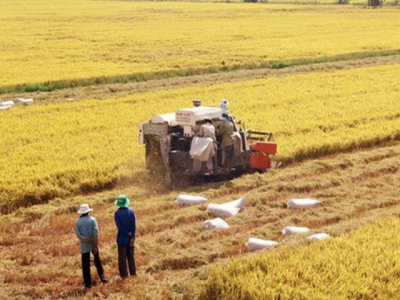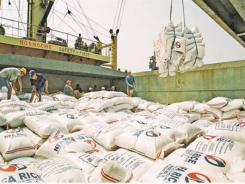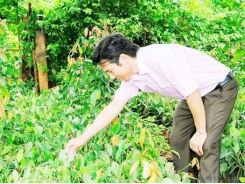Agricultural sector improves value of Vietnamese rice

In recent days, farmers in the Mekong Delta have been flexibly sowing the winter-spring rice crop early to avoid drought and saltwater intrusion at the end of the rice crop. Not only using high-quality rice varieties, but the percentage of farmers using certified rice varieties has also increased rapidly. These are important turning points in improving the quality of rice to enhance the value of Vietnamese rice in the international market.
The Ministry of Agriculture and Rural Development (MARD) has warned of early saline intrusion. It is recommended that localities in the Mekong Delta should plant the winter-spring rice crop early to avoid drought and saltwater intrusion. In the winter-spring rice crop of 2020-2021, provinces in the Mekong Delta will sow more than 1.55 million hectares with the estimated output at 10 million tons.
“At present, over 80 percent of Hau Giang farmers have focused on using fragrant rice varieties and high-quality rice varieties. Of which, for some rice varieties, such as Dai Thom 8 and ST24, many traders have made deposits to buy rice from farmers,” said Mr. Tran Chi Hung, Director of Department of Agriculture and Rural Development of Hau Giang Province. According to Mr. Tran Chi Hung, fortunately, the percentage of farmers using certified rice varieties provided by prestigious seed producers and agricultural extension centers is increasing day by day. This is an opportunity for rice farmers to use certified rice varieties and select high-quality rice varieties to meet the need of exporting enterprises.
More than five years ago, the proportion of low-grade rice varieties in the Mekong Delta was quite large in the production structure when farmers used to have the habit of using IR50404 rice variety, which accounted for 30-40 percent or more. Now, low-grade rice varieties, such as IR5040, merely account for 10-17 percent. Provinces in the Mekong Delta have shifted their rice production structure to focus on the segment of premium rice, creating higher added-value. According to Mr. Nguyen Trung Kien, CEO of Gentraco Company in Can Tho City, the rice export situation in the first days of this year was excellent, especially for the segment of premium rice. The price of 5-percent broken rice is ranging from US$505 to $525 per ton. This price level is as high as Thai rice. Enterprises expect to export about 300,000-400,000 tons of rice in January this year.
Currently, the prices of rice in the Mekong Delta in early-2021 remain at high levels. Accordingly, the prices of paddy range from VND6,800-VND7,200 per kilogram, depending on the variety of rice. Mr. Pham Thai Binh, CEO of Trung An High-Tech Agriculture Joint Stock Company, said that the company was cooperating with farmers to establish high-quality rice-growing areas in Kien Giang, Ca Mau. Hau Giang provinces, and Can Tho City with a total area of 8,000 hectares. In this winter-spring rice crop, about 1,400 hectares of rice would adopt a strict production process without using chemicals to produce clean rice for export to fastidious markets, like the EU.
According to Mr. Pham Thai Binh, local authorities need to find solutions to encourage farmers and enterprises to associate in production in large-scale rice fields. This is a prerequisite for farmers and enterprises to join hands to produce rice following the need of international markets. Only in this way can the restructuring of the rice industry be sustainable. And the income of farmers will also increase.
In the first days of this year, many people were shocked by the information that Vietnam imported rice from India. However, through research, this is a normal response to the need of the market. Many enterprises explained that Vietnam currently lacks low-grade rice for the processing of animal feed, so it is normal to import low-grade rice from India. This also partly explains the first success in the restructuring of rice production in Vietnam. Accordingly, the percentage of high-grade rice varieties is increasingly dominating, whereas low-grade rice varieties, such as IR50404, are decreasing day by day, which partly causes a shortage of raw material for the processing of animal feed.
Có thể bạn quan tâm
Phần mềm

Phối trộn thức ăn chăn nuôi

Pha dung dịch thủy canh

Định mức cho tôm ăn

Phối trộn phân bón NPK

Xác định tỷ lệ tôm sống

Chuyển đổi đơn vị phân bón

Xác định công suất sục khí

Chuyển đổi đơn vị tôm

Tính diện tích nhà kính

Tính thể tích ao hồ



 E-commerce can take Vietnamese farm products to global…
E-commerce can take Vietnamese farm products to global…  Sustainable farming method helps raise Bahnar ethnic farmers’…
Sustainable farming method helps raise Bahnar ethnic farmers’…